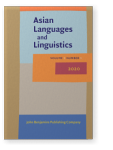Vol. 1:1 (2020) ► pp.34–70
Radical analyticity and radical pro-drop scenarios of diachronic change in East and mainland Southeast Asia, West Africa and Pidgins and Creoles
The paucity or absence of inflectional morphology (radical analyticity) and the omission of verbal arguments with no concomitant agreement (radical pro-drop) are well-known characteristics of East and mainland Southeast Asian languages (EMSEA). Both of them have a special status in typology and linguistic theory. Radical analyticity is known under the term of ‘morphological isolation’ and has recently been described as ‘diachronically anomalous’ (McWhorter 2016), while radical pro-drop is a theoretical challenge since Rizzi (1986). The present paper offers an alternative view on these characteristics based on data from EMSEA languages, radically analytic West African languages and pidgins and creoles. It develops diachronic evolutionary scenarios combining the specific properties of languages in their diachronic and geographic situations with two different notions of complexity (hidden vs. overt complexity) and factors which tend to block the development of inflectional morphological paradigms. From such a perspective, radical analyticity and radical pro-drop are by no means extraordinary. Given the enormous size of the task, the paper is a thought experiment based on available data and discussions on the above languages for stimulating further research.
Article outline
- 1.Setting the stage: The basic idea of the paper
- 2.Radical pro-drop in East and mainland Southeast Asia and in West Africa
- 3.The diachronic strength of inflectional morphological paradigms
- 3.1Absence of inflectional morphological paradigms in EMSEA languages
- 3.2The presence of morphological paradigms in Niger-Congo
- 4.Radical pro-drop in creoles/pidgins and the relevance of inflectional morphological paradigms
- 5.Radical analyticity and radical pro-drop: Scenarios of variation
- 5.1Introduction
- 5.2Hidden vs. overt complexity
- 5.3Factors against the development of extensive inflectional morphological paradigms
- 5.4Morphological paradigms in EMSEA languages
- Inflectional paradigms expressing mainly tense/aspect in Sinitic
- Person/number marking on the verb in the Aslian family of Mon-Khmer
- 5.5On the typological status of radical analyticity and radical pro-drop
- 6.Conclusion
- Notes
- Abbreviations
-
References
This article is currently available as a sample article.
